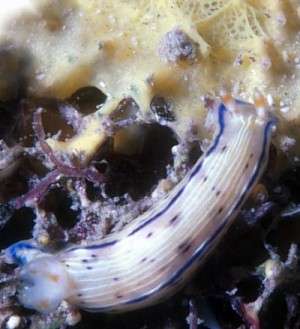
Hypselodoris peasei
(Bergh, 1880)
Order: NUDIBRANCHIA
Suborder: DORIDINA
Superfamily: EUDORIDOIDEA
Family: Chromodorididae
DISTRIBUTION
Known only from Hawaiian Islands of Oahu & Maui.
PHOTO
PHOTOS Scott Johnson
This species has a confused nomenclatural history. Originally named Doris prismatica var. lineata Pease, 1860, and renamed Chromodoris peasei by Bergh (1880), it has more recently been described as Hypselodoris andersoni by Bertsch & Gosliner (1989). It is endemic to Hawaii, and grows to about 20mm in length. Characteristic features of its colour pattern, differentiating it from other white-lined hypselodorids include the two orange bands on the rhinophores, orange line on gills, and the violet border to mantle and foot. Some animals also have small blue spots on the mantle and brownish pink patches near the mantle edge. See Scott Johnson's message for a description of its natural history, and my message for a discussion of its nomenclatural confusion with Hypselodoris bertschi.
See more photos below.
See original description of Dorisprismatica lineata & C. peasei below.
References:
•Johnson, S. (1983) Distribution of two nudibranch species on a subtidal reef on the western shore of Oahu, Hawaii. The Veliger, 25(4): 356-364.
•Bertsch, H. & Gosliner, T.M. (1989) Chromodorid nudibranchs from the Hawaiian Islands. The Veliger, 32(3): 247-265.
•Gosliner, T.M. & Johnson, R.F. (1999) Phylogeny of Hypselodoris (Nudibranchia: Chromodorididae) with a review of the monophyletic clade of Indo-Pacific species, including descriptions of twelve new species. Zoological Journal of the Linnean Society, 125: 1-114.
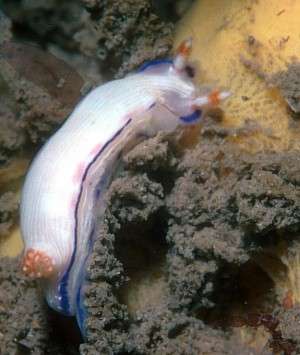
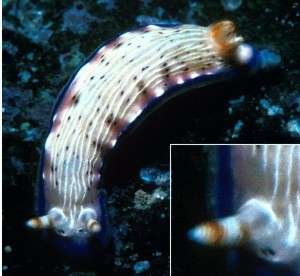
Rudman, W.B., 2000 (February 4) Hypselodoris peasei (Bergh, 1880). [In] Sea Slug Forum. Australian Museum, Sydney. Available from http://www.seaslugforum.net/find/hypspeas
Related messages
Re: Original description & identity of Hypselodoris peasei
February 12, 2000
From: Ron Velarde
Dr. Rudman,
Just a minor point; for Hypselodoris peasei, Bergh, 1880 should be in parentheses as it was originally placed in Chromodoris.
Keep up the good work.
Ron
rgv@sdcity.sannet.gov
Velarde, R., 2000 (Feb 12) Re: Original description & identity of Hypselodoris peasei. [Message in] Sea Slug Forum. Australian Museum, Sydney. Available from http://www.seaslugforum.net/find/1885Dear Ron,
Thanks for noticing my lapse, and thanks even more for letting me know. I try and proof read all the text and check that all the hypertext links work, but for perfection I rely on feedback from all of you who regularly read the Forum.
For any of you who don't understand, or realise, that there is a a convention concerning brackets [parentheses] around the author's name and date in scientific names, this is a good time to mention it. If a species is no longer in the genus it was first placed in, then the first author's name and date should be in brackets. For example. In Terry Gosliner & Rebecca Johnson's excellent recent review of Hypselodoris they have proposed that a species which I described in 1995 as Hypselodoris punicea should be better placed in the genus Thorunna. They therefore refer to it as Thorunna punicea (Rudman, 1995). Another species, like Hypselodoris maridadilus Rudman, 1977, doesn't have brackets in their paper, because they agree with my placement of it in the genus Hypselodoris.
This is a very useful convention, especially today when we rely quite heavily on computerised searches. If you see an author's name in brackets then it's likely you won't find a reference to the original description if you use the present generic name in your search.
Best wishes,
Bill Rudman.
Re: Identity of Hypselodoris peasei
February 12, 2000
From: Terry Gosliner
Dear Bill,
Following your message about the identity of H. peasei, I have had a look at Pease's description of H. lineata var. prismatica and Garrett's figure that you posted and I am convinced that you have it correctly: that H. peasei = H. andersoni. I am glad you have this resolved. What a tortuous history the nomeclature has had!
Best,
Terry
tgosline@calacademy.org
Gosliner, T., 2000 (Feb 12) Re: Identity of Hypselodoris peasei. [Message in] Sea Slug Forum. Australian Museum, Sydney. Available from http://www.seaslugforum.net/find/1890Original description & identity of Hypselodoris peasei
February 10, 2000
From: Bill Rudman
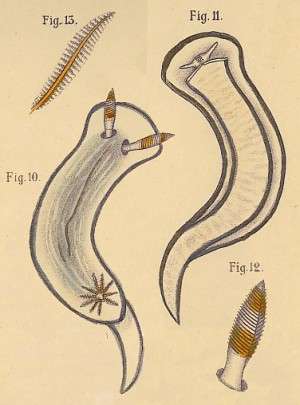
To help in the discussion on Hypselodoris bertschi and Hypselodoris peasei I have included here Pease's original description of Dorisprismatica lineata with paintings from Andrew Garrett, which Bergh (1880) subsequently published, and gave a new name C. peasei, because Pease's name was preoccupied by Eydoux & Souleyet's Doris lineata.
Bill Rudman.
=======================================
40. DORIS PRISMATICA, var. LINEATA
Elongate, soft, smooth, convexly rounded above, rather wider posteriorly, portion anterior to the dorsal tentacles somewhat dilated laterally and rounded in front. Branchiae small, erect, lanceolate, pinnate, ten in number, encircling the vent and retractile into a common cavity, Dorsal tentacles elongate, straight, directed forward and laterally lamellated about two-thirds of their length, and retractile into simple cavities. Foot elongated and projecting much beyond posterior edge of the body in a point, rounded in front. Colour light greyish-purple, along the back and the remainder of body white, irregular longitudinal opaque fine white lines on the dorsal region, some of which are confluent. Margins of foot and body beautifully edged with violet. Branchiae whitish and longitudinally striped with orange. Tentacles white, with an orange zone near the tips, and a second near their base. Length 1 inch.
Text: Pease, W.H. (1860) Proc. zool. Soc. Lond, 28: 32.
Figures: Bergh, L.S.R. (1880) Malac. Unters. Semper. Sect 2, 4(1): 26. Fig B, figs 10-13. [painted by Andrew Garrett].
Hypselodoris 'andersoni' from Hawaii
February 10, 2000
From: Scott Johnson
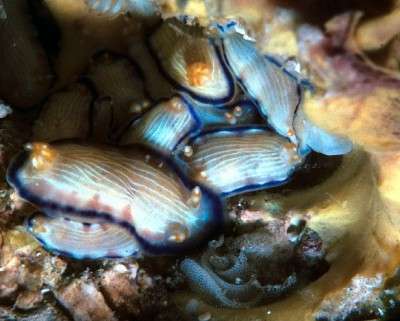
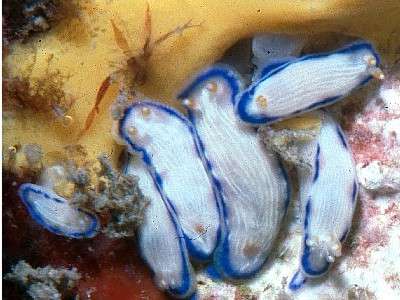
Since the Forum seems to be putting together a good collection of pictures of Hypselodoris species, I thought I'd add another. Attached is an animal I have called 'chromodorid 1' and 'Hypselodoris sp. 1' in a couple of papers in the Veliger. Hans Bertsch and I referred to it as "locust" in our Hawaiian Nudibranchs. Hans and Terry Gosliner finally named it in 1989 as Hypselodoris andersoni.
It's a species with strongly diurnal habits. During the day, it tends to be exposed in the open feeding on yellow sponge (Luffariella sp.), often gathering in groups of up to 30 or more to completely devour sponge colonies (hence the name "locust" -- in lower photo the white patch is bare rock grazed clean of sponge). At night, they crawl inside cavities in the sponge clumps or into holes in the reef to hide, often leaving their egg masses in those holes (bottom centre of upper photo).
While they always have dorsal, close set, white longitudinal lines, they vary in the extent of dorsal spotting and in the development of pink patches along the margins. From my records this species can get up to around 20mm in length.
Scott
johnson@kmr.ll.mit.edu
Johnson, S., 2000 (Feb 10) Hypselodoris 'andersoni' from Hawaii. [Message in] Sea Slug Forum. Australian Museum, Sydney. Available from http://www.seaslugforum.net/find/1856Dear Scott,
Thanks for the photos and information on this and the other lined chromodorids from Hawaii.
As I have discussed in a separate message, I think this species is the real Hypselodoris peasei.
Since I started looking at the chromodorids, I have been fascinated with the white-lined species from Hawaii as they seem to form another group of mimics on the edge of the Indo-West Pacific like the red-spotted group in southeastern Australia. I hope to be able to post the photos you have sent of the other Hawaiian species as soon as possible.
Bill Rudman.
